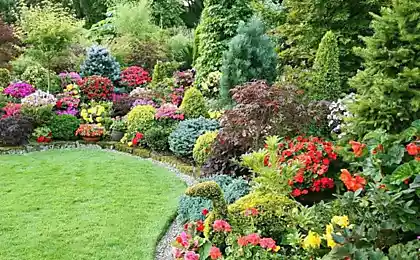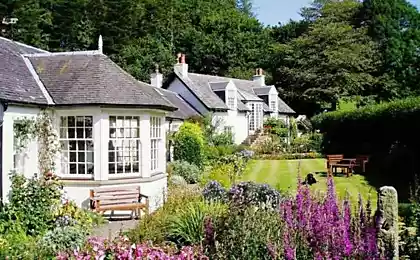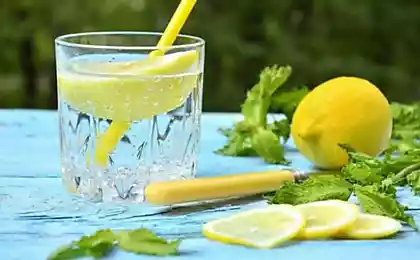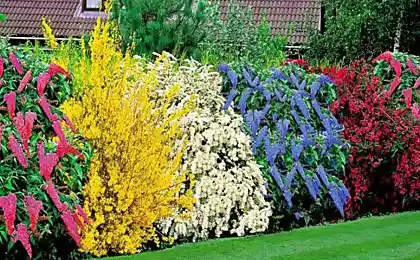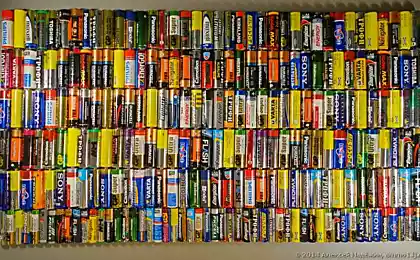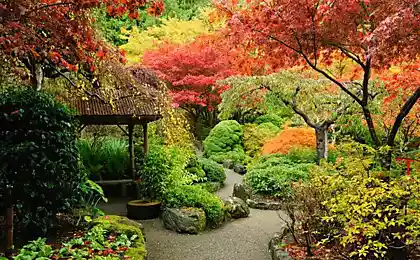795
17 the best ornamental shrubs for alkaline soils
Twenty six million three hundred ten thousand six hundred forty six
On the site we have repeatedly touched on the theme of problem soils what they are, how they improve and what they plant. But somehow all parties avoided alkaline soil that is typical of many southern regions, so try to fill this gap.
What is alkaline soil?No elementary school knowledge of chemistry is not enough, so let's remember what is the pH of the solution. This is an indicator that characterizes its acidity. So, in alkaline soils there is a significant amount of calcium or lime, the soil solution has a high pH. Soils are divided into slightly alkaline (pH 7-8), srednesrochnuyu (pH 8-8,5), strongly alkaline (pH 8.5).
How to determine that the soil is alkaline?The pH value of the soil solution (pH) is determined using litmus paper. To do this, take a handful of soil, fill with distilled water, stir thoroughly to make a creamy mass, which immerse the litmus paper. In an acidic environment it becomes red, alkaline is blue. With a pH of 7.5 or more soils are considered to be slightly alkaline and alkaline.
How to improve alkaline soil before planting?You can improve the soil, if deeply plowed her and make calcium sulfate (gypsum). If the soil in your cottage slightly alkaline, shallow dig it and make a larger dose of organic fertilizers. Helps sowing of green manure (alfalfa, mustard, etc.).
What plants can grow in alkaline soil?A large part of the plants in the country likes soil with a neutral reaction or with minor deviations of acidity. However, on alkaline soils can successfully grow a number of ornamental plants-kaltsefily, that is, those that love alkaline soil. Their selection is considerable, and today we will focus on the best of the best bushes.
Барбарис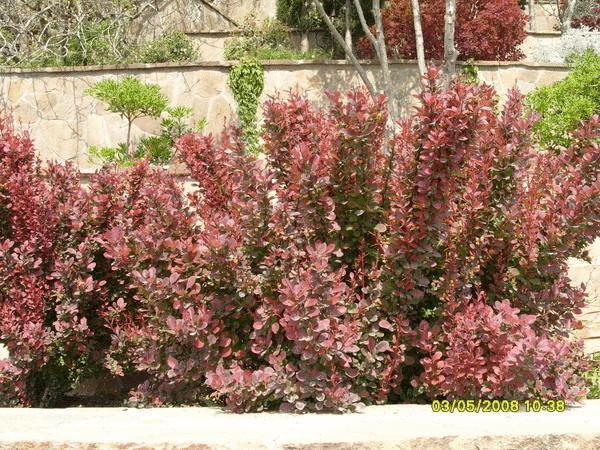
Barberry (Berberis) — spiny shrubs with small, leathery leaves, Golden-yellow fragrant flowers, red, blue or black, juicy, sour berries which stay long on the branches, good in suburban areas in a variety of design elements.
Features kultivirovaniya types barbarisov in Central Russia hardy in varying degrees. Most of them are undemanding to soil, semi-shade, but develops best on light, drought-tolerant, can not tolerate stagnant moisture. Pests are damaged a little. Many types barbarisov are the intermediate host of the rust fungus (Puccinia graminis) that are harmful to crops and therefore should not be placed near fields (a minimum distance of 250-500 m).
Primarilybecause so diverse that they find their place in different groups of woody plants, harmonious in the flower beds with perennials and annuals, spectacular rockeries.
Privet
Twenty seven million five thousand seven hundred ninety one
Common Privet (Ligustrum vulgare) is a deciduous shrub with a height of 2-3 cm, leathery, dark green leaves and fragrant white or cream flowers, gathered in a rather large inflorescences-panicles; blooming in June-August. There are ornamental forms. If the family has allergies, it can not be used!
Features kultivirovaniya ordinary winter-hardy up to the latitude of Bryansk, the eagle, in the Central and Northern parts of Central Russia may be covered with ice above the snow level. It is quite shade-tolerant, but prefers Sunny locations, drought-resistant, undemanding to soil, but grows best on fertile. Can be damaged by aphids, leaf-mining moths, thrips, scale insects; be affected by leaf spot, wilt.
Primenenia.nebolshie advantage Privet common is that it tolerates shearing and long retains the form, so it can be used to create high dense, dense, high, molded curbs, better narrow, single lane. Privet can form very dense, molded hedges with a height of 2-3 m, and even a living wall. Cut the rods used in weaving. Without molding cutting as honey hedges by trimming the sides.
Hawthorn
Twenty one million fifty six thousand three hundred one
Hawthorn (Crataegus) is a long-lived (200-300 years), slow growing, large shrubs, often with spines, the inflorescence of white flowers and edible in most species, pome-shaped fruit.
Features kultivirovaniya light, can tolerate shade but flower and fruit are not so abundant, drought resistant, relatively undemanding to the soil. Grow well on calcareous soft hawthorn, hawthorn krupnokuskovoy etc. Damaged a significant number of pests and diseases, which are common with traditional fruit plants. The main pests are the butterflies (especially aporia Crataegi), aphids, Apple mealybug, beetles vetoed; of diseases – powdery mildew and leaf rust.
Primeneniya as the hawthorns excellent transfer molding cut that contributes to the development of the spines, they are one of the best breeds to create beautiful, and highly prickly types – and completely impenetrable molded hedges, hedge fences and free-growing living walls.
Bobovnik
Eleven million one hundred nineteen thousand three hundred sixty one
Bobovnik ordinary (Laburnum anagyroides) — luxury Golden shrub with drooping Golden-yellow long, up to 30 cm tassels; bloom in may-June. The whole plant is poisonous!
Features kultivirovanija common – sybarite: in the middle zone of Russia may be covered with ice after a wet summer, but Krona is quickly restored. Light, it develops better in fertile, well-drained, lime-containing soils.
Primaverasound good as solitary, in group planting. Many gardeners lovers, seeing in the Internet the pergola with the hanging Golden waterfall of blossoming bobovnik, dream about the same, but this is only possible in the southern regions with good care.
Sambucus nigra
Forty five million five hundred thirty three thousand eight hundred twenty six
Black elderberry (Sambucus nigra) is a tall, spreading deciduous shrub. Not stand out for the beauty of its small yellowish-white flowers in flat inflorescences corymbs, but so many of them that the elder may worthily competes with flowering Kalina. The fruits are shiny, black, small, ripen in August-September, and the elder once again transformed, decorated them. Grow faster. Bred fruit varieties with larger than the species, berries. There are ornamental forms.
Features kultivirovaniya black winter hardy up to the latitude of Bryansk and Orel. It is resistant to shade, but the bright colors of the decorative form is better seen in the sun should avoid direct sunlight, can cause burns to the young leaves. The elderberry needs fertile soils, tolerates dry air and soil salinization. Can be damaged by aphids, black fly and marvel at verticillatum.
Primenenie black elderberry can be quickly formed (by cutting) molded or free-growing flowering, fruit, medicinal hedges. Dwarf form ‘Nana’ is good in borders and low hedges. Variegated and zheltolistnye form suitable for a very spectacular, colorful hedges.
Hibiscus сирийский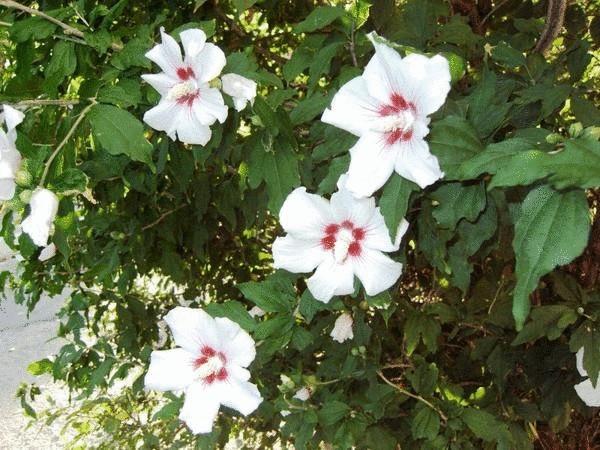
The Syrian hibiscus (Hibiscus syriacus) is a very showy deciduous shrub with red-purple, pink-purple, rarely white, large, broadly, often double flowers, which bloom from June to September.
Features kultivirovaniya, it tolerates winters in the southern regions without shelter. Light-requiring, drought resistant to the soil a little demanding, it develops better on friable loam.
Parmentierlaan and self-sufficient in single and group plantings; finds its place in mixed borders, free-growing hedges. Valued for the late summer prolonged (prolonged) blooms.
The Cornel, or dogwood male (ordinary)
Fifty seven million one hundred thirty eight thousand three hundred sixty nine
Derain mens, or ordinary, he's a dogwood (Cornus mas) — modest, densely branched, long-lasting, slow-growing, deciduous shrub, height up to 5 m with Golden-yellow flowers, which bloom in March-April, before the leaves appear. One of the most ranotsvetuschih woody species that provide the first food for the bees, come to life after winter hibernation. The fruits are edible, cylindrical or pyriform, red, ripen in August-September. There are ornamental forms.
Features of cultivation
Dogwood men's winter-hardy enough in Central Russia in the harsh winter, the young shoots may be covered with ice. Light-requiring, but tolerates considerable shade, dry soil, but prefers rich, fresh, moist loam and limestone.
Application
Dogwood men's suitable for free-growing or trellis, flowering, honey, fruit hedges; can be used for topiary.
Cotoneaster (cotoneaster) types, varieties
Thirty nine million eighty seven thousand four hundred fifty one
Despite the fact that cotoneaster do not differ special beauty of their flowers, leaves and fruits, nevertheless, they are popular in landscaping. It is a deciduous and evergreen slow growing densely branched shrubs with small or medium-sized, simple leaves, white or pink flowers, gathered in corymbs or brush, small, red or black fruit.
Features of cultivation
Cotoneaster shade tolerant, undemanding to the soil, drought resistant.
Application
Cotoneaster has long been caught in the cottages and this is no accident: they have a lot of advantages. They are good honey plants. They are decorative during flowering, fruit ripening, and in autumn attire. Successfully lend themselves to molding cutting, forming dense hedges. After pruning grow strongly, while maintaining the shape of growth. Allowed trim 1/3 the length of a year escape. Can be damaged by the bear.
Lavender узколистная
Lavender angustifolia (Lavandula angustifolia) is a densely branched, bluish-green, evergreen, fragrant, low shrub. The flowers are small, blue to purple in color, rarely white-pink, in spike-like inflorescences, bloom in June-August.
Features of kultivirovaniya Yuzhanka lavender angustifolia can withstand temperatures down to -25 °C, in the South of Central Russia, it can spend the winter under the snow or in the shelter of spruce branches. Among its advantages and disadvantages of the following: light-requiring, drought-resistant, not demanding to soil, grows well and blooms in dry, drained, calcareous; sensitive to waterlogging, excess urea (avoid walking Pets near lavender hedges).
Application
Lavender angustifolia is good in mixed borders, rockeries, freely growing edges (placing plants in a row of 20-30 cm depending on the size of the forms; possible dual row planting with a row spacing of 40 cm).
The rosemary
Seventy seven million eight hundred eighty nine thousand thirty five
The rosemary (Rosmarinus officinalis) — evergreen, low shrub with fragrant flowers of white, pale blue to light purple colors. Flowers bloom in spring, summer, autumn and winter are often. Is growing relatively quickly. Durable.
Features kultivirovaniya southerner rosemary by lowering the temperature to -15 °C is frosting! It is light-requiring, drought-resistant, undemanding to soil, it grows on dry, rocky, sandy, saline; sensitive to excess moisture, shading.
Application
The rosemary in the southern regions into the molded good (with pruning after flowering) or free growing (trim the sides) spicy borders, low hedges.
Buxus sempervirens
Ninety million nine hundred forty three thousand nine hundred eighty one
The evergreen boxwood (Buxus sempervirens) is a slow-growing, densely branched, evergreen shrub, which since ancient times is the best material for topiary.
Features kultivirovaniya on their "venezuelanos", the boxwood can withstand the snow without damage cold -20...-22 °C and good winters in the latitude of Moscow and St. Petersburg. It is quite shade-tolerant, but grows well in full sun (especially variegated forms), prefers limy, fertile soil, does not like waterlogging.
Primeneniia typically used for molded, dense borders, in the South – and for hedges. Low curbs (especially from the form ‘Suffruticosa’) can arrange for flower beds or vegetable beds. Each meter is 10-15 plants that subsequently cut their hair regularly from spring to late summer.
Sumac обыкновенная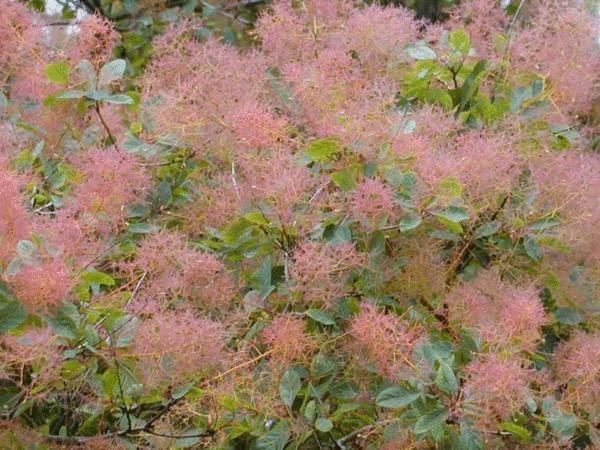
Many people know this original shrub for autumn decoration red, "burning" of foliage clothing the Bush to the ground, and fruit panicles that turn bushes scumpii in colorful bouquets. When the vase life gives abundant shoots from the stump. There are ornamental forms.
Features kultivirovanija common (Cotinus coggygria) is quite hardy, but in the middle zone of Russia in the harsh winter may be covered with ice, especially at a young age. Forms are less hardy. Light-requiring, drought resistant, can tolerate moderate shading, is relatively undemanding to soil, can grow on Sands and saline soils, responds well to the presence of lime in the soil.
Primeneniyu the sumac in soliternyh and group plantings, as well as in freely growing hedges.
Spiraea, or таволга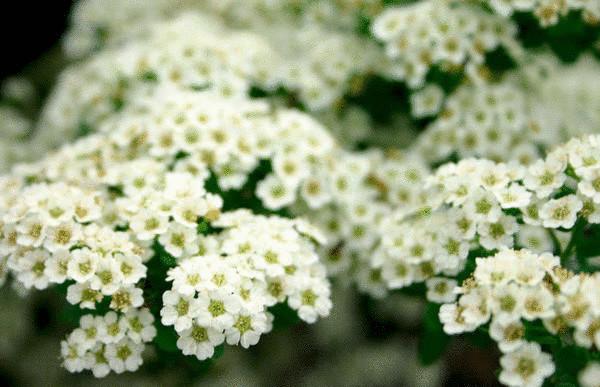
Spirea, or meadowsweet (Spiraea) is gustooblistvennye shrubs up to 2 m with a variety of Bush form, often with curved branches, decorated in the period of flowering white, pink, red blossoms that bloom in spring or summer, long, abundant. Grow faster. Has many decorative forms.
Features kultivirovalis species are hardy over a relatively large area. In the middle zone of Russia only in very severe winters, a slight freezing of young shoots in some species (Spiraea nipponskoy, Sirenetta, Japanese). Light, some species tolerate slight shading (dubravkina spirea spirea medium), is quite unpretentious, it is better to develop fertile, well-drained soils. Can be damaged by Sawfly blue targowym, spiraeas and beet aphids, Midge tolgonai treatments.
Presentiation dressed in the period of flowering shrubs. They tolerate a haircut, after which quickly restore the crown. Often they are used in moulded borders, which is not quite a good decision, since if you cut and remove "the color." It is better to plant spirea in the free-growing borders and low hedges with the removal of half the length of the withered shoots after flowering and, if necessary, easy podmanivaya cropping the sides. The distance between plants in the rows 0.4-0.5 m, between rows of 0.3-0.4 m.
Tamarisk, or гребенщик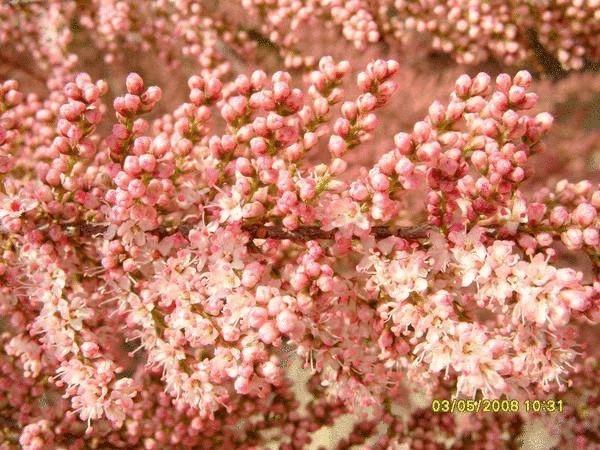
Tamarisk, tamarisk (Tamarix) — a very peculiar shrub, as if worn on your rod, reddish brown shoots of small "beads" pale pink flowers. Little scaly light green leaves are not visible. This beauty blooms in spring in may or in late summer – early autumn. Grow faster. Durable.
Features kultivirovaniya has low winter-hardiness, some types (Tamarix juniper and tamarisk branched) can grow in Central Russia, with minor freezing of young shoots. They are light, undemanding to the soil, can grow on poor Sands and make significant salinization. Indispensable use for saline soils and loose Sands. Resistant to pests and diseases.
Primegenerator beautiful high hedges, or molded with an annual cut on the stump (the fence will consist of annual shoots with flowering of it in the same year).
Forsythia
Forsythia (Forsythia) — a small Golden-yellow shrubs, long blooming in early spring, mostly before the appearance of the leaves.
Features kultivirovaniya winter-hardy in Central Russia is forsythia ovata, and other species can be grown here, with shelter with dry leaves, spruce branches and prigibanie branches to the ground. Drought tolerant, avoid excessive moisture in the soil, prefer wind-protected, Sunny locations but can grow in shade, are relatively undemanding to soil, grow well in light, sour. Cut forsythia not in the spring and after flowering in mid-summer because the flower buds of this shrub are laid in the summer of the previous year. The best time for trimming the end of June.
Primeneniya forsythia in the spring at the cottage! Like the sun marked the Bush "highlights" every corner of the garden. Good she's in solitary and group plantings in free-growing hedges of medium height. Forsythia is suitable for distillation (January-March, flowers bloom in the indoor environment 8-12 days), and cutting flowering branches for bouquets. Practice mowing the borders of Portici deprives these shrubs in the beauty of the spring bloom.
The Japan quince
The Japan quince (Chaenomeles) blooms in early spring (some forms before the leaves), is a deciduous, thorny, low bushes. During flowering Japan quince dresses spring garden in a truly festive attire. Breeders worked hard and brought the whole hybrid group and numerous varieties with red, crimson, orange and white flowers. Fruits – a variety of shapes and colors, sour, very aromatic apples.
Features kultivirovanija quite winter-hardy in Central Russia (except for Japan quince fine). However, young plants better shelter spruce branches. Prefer open Sunny places, are relatively drought tolerant, but in hot, dry summer need watering, grow best on fertile soils. Relatively stable, sometimes can be damaged by scale insects, aphids; be affected by brown rot, bacterial blight, coral spot, Fusarium.
Primenenie.html indispensable in the creation of low, free-growing, thorny hedges and borders, with a possible shallow trimming the sides. They can be used as vygonochnyh culture (January-March) and for cutting. When planting is necessary to consider that the seedlings bloom on 3-4th year, can vary greatly in height, shape of shrubs, flowers, fruit weight, therefore, for laying hedges better use of vegetatively propagated planting material.
Chubushnik (Philadelphus) — luxury scented shrub up to 4 m, with white or creamy-white flowers. Good honey plant.
Features kultivirovaniya quite hardy, but in Central Russia, in the winter, maybe freezing the ends of annual shoots of the mock orange and coronary chubushnika cordata, as well as ornamental varieties of foreign selection. They are shade-tolerant, but bloom best lit areas are sensitive to soil fertility and moisture. May damage spider mites, bean aphids, the green leaf weevil.
Pretentiously, often called the garden of Jasmine, has long been settled in many cottages. Its types and varieties were loved by all members of the family, and now from year to year, all waiting for their dazzling flowering, which gives a sense of joy and love. The mock oranges are well-suited for forming the hair, giving a dense hedge, but still it is preferable to use for free-growing high-and medium-sized hedges and borders with trimming overhanging shoots. The minimum distance between plants 0.5 m.
On alkaline soils also grow well and bloom many varieties of roses, but this topic is so vast that it is impossible to devote only a small paragraph in this article. About the cultivation of roses website there are a variety of materials, for example:
As spacionaute, that is highly alkaline soils are not suitable for growing grapes and most fruit crops, which in this case start to hurt chlorosis (leaves turn yellow, wither and do not grow the tops of the shoots). But at moderate alkalinisation, and at pH less than 8, it is possible to plant and harvest pear, quince, peach, apricot, dogwood, cherry, walnut, almond, mulberry, and some other fruit crops.
Many plants do not tolerate a large percentage of lime, so in alkaline soil to plant them (rhododendrons, azaleas, heathers etc.).
Amidst pine for alkaline soils suitable for the following:
Source: www.7dach.ru
On the site we have repeatedly touched on the theme of problem soils what they are, how they improve and what they plant. But somehow all parties avoided alkaline soil that is typical of many southern regions, so try to fill this gap.
What is alkaline soil?No elementary school knowledge of chemistry is not enough, so let's remember what is the pH of the solution. This is an indicator that characterizes its acidity. So, in alkaline soils there is a significant amount of calcium or lime, the soil solution has a high pH. Soils are divided into slightly alkaline (pH 7-8), srednesrochnuyu (pH 8-8,5), strongly alkaline (pH 8.5).
How to determine that the soil is alkaline?The pH value of the soil solution (pH) is determined using litmus paper. To do this, take a handful of soil, fill with distilled water, stir thoroughly to make a creamy mass, which immerse the litmus paper. In an acidic environment it becomes red, alkaline is blue. With a pH of 7.5 or more soils are considered to be slightly alkaline and alkaline.
How to improve alkaline soil before planting?You can improve the soil, if deeply plowed her and make calcium sulfate (gypsum). If the soil in your cottage slightly alkaline, shallow dig it and make a larger dose of organic fertilizers. Helps sowing of green manure (alfalfa, mustard, etc.).
What plants can grow in alkaline soil?A large part of the plants in the country likes soil with a neutral reaction or with minor deviations of acidity. However, on alkaline soils can successfully grow a number of ornamental plants-kaltsefily, that is, those that love alkaline soil. Their selection is considerable, and today we will focus on the best of the best bushes.
Барбарис

Barberry (Berberis) — spiny shrubs with small, leathery leaves, Golden-yellow fragrant flowers, red, blue or black, juicy, sour berries which stay long on the branches, good in suburban areas in a variety of design elements.
Features kultivirovaniya types barbarisov in Central Russia hardy in varying degrees. Most of them are undemanding to soil, semi-shade, but develops best on light, drought-tolerant, can not tolerate stagnant moisture. Pests are damaged a little. Many types barbarisov are the intermediate host of the rust fungus (Puccinia graminis) that are harmful to crops and therefore should not be placed near fields (a minimum distance of 250-500 m).
Primarilybecause so diverse that they find their place in different groups of woody plants, harmonious in the flower beds with perennials and annuals, spectacular rockeries.
Privet
Twenty seven million five thousand seven hundred ninety one
Common Privet (Ligustrum vulgare) is a deciduous shrub with a height of 2-3 cm, leathery, dark green leaves and fragrant white or cream flowers, gathered in a rather large inflorescences-panicles; blooming in June-August. There are ornamental forms. If the family has allergies, it can not be used!
Features kultivirovaniya ordinary winter-hardy up to the latitude of Bryansk, the eagle, in the Central and Northern parts of Central Russia may be covered with ice above the snow level. It is quite shade-tolerant, but prefers Sunny locations, drought-resistant, undemanding to soil, but grows best on fertile. Can be damaged by aphids, leaf-mining moths, thrips, scale insects; be affected by leaf spot, wilt.
Primenenia.nebolshie advantage Privet common is that it tolerates shearing and long retains the form, so it can be used to create high dense, dense, high, molded curbs, better narrow, single lane. Privet can form very dense, molded hedges with a height of 2-3 m, and even a living wall. Cut the rods used in weaving. Without molding cutting as honey hedges by trimming the sides.
Hawthorn
Twenty one million fifty six thousand three hundred one
Hawthorn (Crataegus) is a long-lived (200-300 years), slow growing, large shrubs, often with spines, the inflorescence of white flowers and edible in most species, pome-shaped fruit.
Features kultivirovaniya light, can tolerate shade but flower and fruit are not so abundant, drought resistant, relatively undemanding to the soil. Grow well on calcareous soft hawthorn, hawthorn krupnokuskovoy etc. Damaged a significant number of pests and diseases, which are common with traditional fruit plants. The main pests are the butterflies (especially aporia Crataegi), aphids, Apple mealybug, beetles vetoed; of diseases – powdery mildew and leaf rust.
Primeneniya as the hawthorns excellent transfer molding cut that contributes to the development of the spines, they are one of the best breeds to create beautiful, and highly prickly types – and completely impenetrable molded hedges, hedge fences and free-growing living walls.
Bobovnik
Eleven million one hundred nineteen thousand three hundred sixty one
Bobovnik ordinary (Laburnum anagyroides) — luxury Golden shrub with drooping Golden-yellow long, up to 30 cm tassels; bloom in may-June. The whole plant is poisonous!
Features kultivirovanija common – sybarite: in the middle zone of Russia may be covered with ice after a wet summer, but Krona is quickly restored. Light, it develops better in fertile, well-drained, lime-containing soils.
Primaverasound good as solitary, in group planting. Many gardeners lovers, seeing in the Internet the pergola with the hanging Golden waterfall of blossoming bobovnik, dream about the same, but this is only possible in the southern regions with good care.
Sambucus nigra
Forty five million five hundred thirty three thousand eight hundred twenty six
Black elderberry (Sambucus nigra) is a tall, spreading deciduous shrub. Not stand out for the beauty of its small yellowish-white flowers in flat inflorescences corymbs, but so many of them that the elder may worthily competes with flowering Kalina. The fruits are shiny, black, small, ripen in August-September, and the elder once again transformed, decorated them. Grow faster. Bred fruit varieties with larger than the species, berries. There are ornamental forms.
Features kultivirovaniya black winter hardy up to the latitude of Bryansk and Orel. It is resistant to shade, but the bright colors of the decorative form is better seen in the sun should avoid direct sunlight, can cause burns to the young leaves. The elderberry needs fertile soils, tolerates dry air and soil salinization. Can be damaged by aphids, black fly and marvel at verticillatum.
Primenenie black elderberry can be quickly formed (by cutting) molded or free-growing flowering, fruit, medicinal hedges. Dwarf form ‘Nana’ is good in borders and low hedges. Variegated and zheltolistnye form suitable for a very spectacular, colorful hedges.
Hibiscus сирийский

The Syrian hibiscus (Hibiscus syriacus) is a very showy deciduous shrub with red-purple, pink-purple, rarely white, large, broadly, often double flowers, which bloom from June to September.
Features kultivirovaniya, it tolerates winters in the southern regions without shelter. Light-requiring, drought resistant to the soil a little demanding, it develops better on friable loam.
Parmentierlaan and self-sufficient in single and group plantings; finds its place in mixed borders, free-growing hedges. Valued for the late summer prolonged (prolonged) blooms.
The Cornel, or dogwood male (ordinary)
Fifty seven million one hundred thirty eight thousand three hundred sixty nine
Derain mens, or ordinary, he's a dogwood (Cornus mas) — modest, densely branched, long-lasting, slow-growing, deciduous shrub, height up to 5 m with Golden-yellow flowers, which bloom in March-April, before the leaves appear. One of the most ranotsvetuschih woody species that provide the first food for the bees, come to life after winter hibernation. The fruits are edible, cylindrical or pyriform, red, ripen in August-September. There are ornamental forms.
Features of cultivation
Dogwood men's winter-hardy enough in Central Russia in the harsh winter, the young shoots may be covered with ice. Light-requiring, but tolerates considerable shade, dry soil, but prefers rich, fresh, moist loam and limestone.
Application
Dogwood men's suitable for free-growing or trellis, flowering, honey, fruit hedges; can be used for topiary.
Cotoneaster (cotoneaster) types, varieties
Thirty nine million eighty seven thousand four hundred fifty one
Despite the fact that cotoneaster do not differ special beauty of their flowers, leaves and fruits, nevertheless, they are popular in landscaping. It is a deciduous and evergreen slow growing densely branched shrubs with small or medium-sized, simple leaves, white or pink flowers, gathered in corymbs or brush, small, red or black fruit.
Features of cultivation
Cotoneaster shade tolerant, undemanding to the soil, drought resistant.
Application
Cotoneaster has long been caught in the cottages and this is no accident: they have a lot of advantages. They are good honey plants. They are decorative during flowering, fruit ripening, and in autumn attire. Successfully lend themselves to molding cutting, forming dense hedges. After pruning grow strongly, while maintaining the shape of growth. Allowed trim 1/3 the length of a year escape. Can be damaged by the bear.
Lavender узколистная

Lavender angustifolia (Lavandula angustifolia) is a densely branched, bluish-green, evergreen, fragrant, low shrub. The flowers are small, blue to purple in color, rarely white-pink, in spike-like inflorescences, bloom in June-August.
Features of kultivirovaniya Yuzhanka lavender angustifolia can withstand temperatures down to -25 °C, in the South of Central Russia, it can spend the winter under the snow or in the shelter of spruce branches. Among its advantages and disadvantages of the following: light-requiring, drought-resistant, not demanding to soil, grows well and blooms in dry, drained, calcareous; sensitive to waterlogging, excess urea (avoid walking Pets near lavender hedges).
Application
Lavender angustifolia is good in mixed borders, rockeries, freely growing edges (placing plants in a row of 20-30 cm depending on the size of the forms; possible dual row planting with a row spacing of 40 cm).
The rosemary
Seventy seven million eight hundred eighty nine thousand thirty five
The rosemary (Rosmarinus officinalis) — evergreen, low shrub with fragrant flowers of white, pale blue to light purple colors. Flowers bloom in spring, summer, autumn and winter are often. Is growing relatively quickly. Durable.
Features kultivirovaniya southerner rosemary by lowering the temperature to -15 °C is frosting! It is light-requiring, drought-resistant, undemanding to soil, it grows on dry, rocky, sandy, saline; sensitive to excess moisture, shading.
Application
The rosemary in the southern regions into the molded good (with pruning after flowering) or free growing (trim the sides) spicy borders, low hedges.
Buxus sempervirens
Ninety million nine hundred forty three thousand nine hundred eighty one
The evergreen boxwood (Buxus sempervirens) is a slow-growing, densely branched, evergreen shrub, which since ancient times is the best material for topiary.
Features kultivirovaniya on their "venezuelanos", the boxwood can withstand the snow without damage cold -20...-22 °C and good winters in the latitude of Moscow and St. Petersburg. It is quite shade-tolerant, but grows well in full sun (especially variegated forms), prefers limy, fertile soil, does not like waterlogging.
Primeneniia typically used for molded, dense borders, in the South – and for hedges. Low curbs (especially from the form ‘Suffruticosa’) can arrange for flower beds or vegetable beds. Each meter is 10-15 plants that subsequently cut their hair regularly from spring to late summer.
Sumac обыкновенная

Many people know this original shrub for autumn decoration red, "burning" of foliage clothing the Bush to the ground, and fruit panicles that turn bushes scumpii in colorful bouquets. When the vase life gives abundant shoots from the stump. There are ornamental forms.
Features kultivirovanija common (Cotinus coggygria) is quite hardy, but in the middle zone of Russia in the harsh winter may be covered with ice, especially at a young age. Forms are less hardy. Light-requiring, drought resistant, can tolerate moderate shading, is relatively undemanding to soil, can grow on Sands and saline soils, responds well to the presence of lime in the soil.
Primeneniyu the sumac in soliternyh and group plantings, as well as in freely growing hedges.
Spiraea, or таволга

Spirea, or meadowsweet (Spiraea) is gustooblistvennye shrubs up to 2 m with a variety of Bush form, often with curved branches, decorated in the period of flowering white, pink, red blossoms that bloom in spring or summer, long, abundant. Grow faster. Has many decorative forms.
Features kultivirovalis species are hardy over a relatively large area. In the middle zone of Russia only in very severe winters, a slight freezing of young shoots in some species (Spiraea nipponskoy, Sirenetta, Japanese). Light, some species tolerate slight shading (dubravkina spirea spirea medium), is quite unpretentious, it is better to develop fertile, well-drained soils. Can be damaged by Sawfly blue targowym, spiraeas and beet aphids, Midge tolgonai treatments.
Presentiation dressed in the period of flowering shrubs. They tolerate a haircut, after which quickly restore the crown. Often they are used in moulded borders, which is not quite a good decision, since if you cut and remove "the color." It is better to plant spirea in the free-growing borders and low hedges with the removal of half the length of the withered shoots after flowering and, if necessary, easy podmanivaya cropping the sides. The distance between plants in the rows 0.4-0.5 m, between rows of 0.3-0.4 m.
Tamarisk, or гребенщик

Tamarisk, tamarisk (Tamarix) — a very peculiar shrub, as if worn on your rod, reddish brown shoots of small "beads" pale pink flowers. Little scaly light green leaves are not visible. This beauty blooms in spring in may or in late summer – early autumn. Grow faster. Durable.
Features kultivirovaniya has low winter-hardiness, some types (Tamarix juniper and tamarisk branched) can grow in Central Russia, with minor freezing of young shoots. They are light, undemanding to the soil, can grow on poor Sands and make significant salinization. Indispensable use for saline soils and loose Sands. Resistant to pests and diseases.
Primegenerator beautiful high hedges, or molded with an annual cut on the stump (the fence will consist of annual shoots with flowering of it in the same year).
Forsythia
Forsythia (Forsythia) — a small Golden-yellow shrubs, long blooming in early spring, mostly before the appearance of the leaves.
Features kultivirovaniya winter-hardy in Central Russia is forsythia ovata, and other species can be grown here, with shelter with dry leaves, spruce branches and prigibanie branches to the ground. Drought tolerant, avoid excessive moisture in the soil, prefer wind-protected, Sunny locations but can grow in shade, are relatively undemanding to soil, grow well in light, sour. Cut forsythia not in the spring and after flowering in mid-summer because the flower buds of this shrub are laid in the summer of the previous year. The best time for trimming the end of June.
Primeneniya forsythia in the spring at the cottage! Like the sun marked the Bush "highlights" every corner of the garden. Good she's in solitary and group plantings in free-growing hedges of medium height. Forsythia is suitable for distillation (January-March, flowers bloom in the indoor environment 8-12 days), and cutting flowering branches for bouquets. Practice mowing the borders of Portici deprives these shrubs in the beauty of the spring bloom.
The Japan quince
The Japan quince (Chaenomeles) blooms in early spring (some forms before the leaves), is a deciduous, thorny, low bushes. During flowering Japan quince dresses spring garden in a truly festive attire. Breeders worked hard and brought the whole hybrid group and numerous varieties with red, crimson, orange and white flowers. Fruits – a variety of shapes and colors, sour, very aromatic apples.
Features kultivirovanija quite winter-hardy in Central Russia (except for Japan quince fine). However, young plants better shelter spruce branches. Prefer open Sunny places, are relatively drought tolerant, but in hot, dry summer need watering, grow best on fertile soils. Relatively stable, sometimes can be damaged by scale insects, aphids; be affected by brown rot, bacterial blight, coral spot, Fusarium.
Primenenie.html indispensable in the creation of low, free-growing, thorny hedges and borders, with a possible shallow trimming the sides. They can be used as vygonochnyh culture (January-March) and for cutting. When planting is necessary to consider that the seedlings bloom on 3-4th year, can vary greatly in height, shape of shrubs, flowers, fruit weight, therefore, for laying hedges better use of vegetatively propagated planting material.
Chubushnik (Philadelphus) — luxury scented shrub up to 4 m, with white or creamy-white flowers. Good honey plant.
Features kultivirovaniya quite hardy, but in Central Russia, in the winter, maybe freezing the ends of annual shoots of the mock orange and coronary chubushnika cordata, as well as ornamental varieties of foreign selection. They are shade-tolerant, but bloom best lit areas are sensitive to soil fertility and moisture. May damage spider mites, bean aphids, the green leaf weevil.
Pretentiously, often called the garden of Jasmine, has long been settled in many cottages. Its types and varieties were loved by all members of the family, and now from year to year, all waiting for their dazzling flowering, which gives a sense of joy and love. The mock oranges are well-suited for forming the hair, giving a dense hedge, but still it is preferable to use for free-growing high-and medium-sized hedges and borders with trimming overhanging shoots. The minimum distance between plants 0.5 m.
On alkaline soils also grow well and bloom many varieties of roses, but this topic is so vast that it is impossible to devote only a small paragraph in this article. About the cultivation of roses website there are a variety of materials, for example:
As spacionaute, that is highly alkaline soils are not suitable for growing grapes and most fruit crops, which in this case start to hurt chlorosis (leaves turn yellow, wither and do not grow the tops of the shoots). But at moderate alkalinisation, and at pH less than 8, it is possible to plant and harvest pear, quince, peach, apricot, dogwood, cherry, walnut, almond, mulberry, and some other fruit crops.
Many plants do not tolerate a large percentage of lime, so in alkaline soil to plant them (rhododendrons, azaleas, heathers etc.).
Amidst pine for alkaline soils suitable for the following:
- junipers;
- blue spruce;
- pines;
- platycladus orientalis.
- kirkazon macrophylla;
- clematises;
- perfoliate honeysuckle;
- parthenocissus five - and trachelectomy.published
Source: www.7dach.ru
Unique stone flowers China
Robot-humanoid Robotics company Hanson responds to facial expressions of the person



